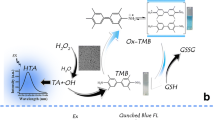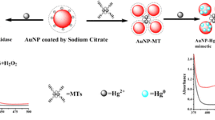Abstract
It is shown that metallothionein-stabilized copper nanoclusters (MT-CuNCs) display catalase-like activity. In the presence of either lead(II) or mercury(II), the catalase-like activity is converted to a peroxidase-like activity. On addition of Pb(II) or Hg(II), the inhibitory effect of MT-CuNCs on the chromogenic reaction of 3,3′,5,5′-tetramethylbenzidine (TMB) with H2O2 is weakened. On the other hand, the catalytic effect of the nanoclusters on the chromogenic reaction is increased. The system MT-CuNCs-Pb(II)/Hg(II) exhibits high affinity for the substrates TMB and H2O2. Their catalytic behavior follows Michaelis-Menten kinetics. Based on these findings, a method was developed for visual detection (via the blue coloration formed) and spectrophotometric determination (at 450 nm) of Pb(II) and Hg(II). The linear range for Pb(II) extends from 0.7 to 96 μM, and the linear ranges for Hg(II) from 97 nM to 2.3 μM and from 3.1 μM to 15.6 μM. The detection limits are 142 nM for Pb(II) and 43.8 nM for Hg(II).

Metallothionein-stabilized copper nanoclusters (MT-CuNCs) display catalase-like activity. On addition of Pb(II) or Hg(II), the catalase-like activity is converted to a peroxidase-like activity. The latter catalyzes the oxidation of 3,3′,5,5′-tetramethylbenzidine (TMB) by H2O2.






Similar content being viewed by others
References
Zhang HL, Ma KX, Yang YJ, Shi CY, Chen GW, Liu DZ (2018) Molecular cloning, characterization, expression and enzyme activity of catalase from planarian Dugesia japonica in response to environmental pollutants. Ecotoxicol Environ Saf 165:88–95
Shi Y, Yang M, Liu L, Pang Y, Long Y, Zheng H (2018) GTP as a peroxidase-mimic to mediate enzymatic cascade reaction for alkaline phosphatase detection and alkaline phosphatase-linked immunoassay. Sensors Actuators B Chem 275:43–49
Zhang T, Cao C, Tang X, Cai Y, Yang C, Pan Y (2017) Enhanced peroxidase activity and tumour tissue visualization by cobalt-doped magnetoferritin nanoparticles. Nanotechnology 28:045704
Wei H, Wang E (2008) Fe3O4 magnetic nanoparticles as peroxidase mimetics and their applications in H2O2 and glucose detection. Anal Chem 80:2250–2254
Tao Y, Lin YH, Huang ZZ, Ren JS, Qu X (2013) Incorporating graphene oxide and gold nanoclusters: a synergistic catalyst with surprisingly high peroxidase-like activity over a broad pH range and its application for cancer cell detection. Adv Mater 25:2510–2510
Tao Y, Lin YH, Ren J, Qu X (2013) A dual fluorometric and colorimetric sensor for dopamine based on BSA-stabilized Au nanoclusters. Biosens Bioelectron 42:41–46
Liu Y, Ding D, Zhen YL, Guo R (2017) Amino acid-mediated ‘turn-off/turn-on’ nanozyme activity of gold nanoclusters for sensitive and selective detection of copper ions and histidine. Biosens Bioelectron 92:140–146
Santhosh M, Chinnadayyala SR, Kakoti A, Goswami P (2014) Selective and sensitive detection of free bilirubin in blood serum using human serum albumin stabilized gold nanoclusters as fluorometric and colorimetric probe. Biosens Bioelectron 59:370–376
Tao Y, Lin Y, Huang Z, Ren J, Qu X (2012) Poly(acrylic acid)-templated silver nanoclusters as a platform for dual fluorometric turn-on and colorimetric detection of mercury (II) ions. Talanta 88:290–294
Li CL, Liu KT, Lin YW, Chang HT (2011) Fluorescence detection of lead(II) ions through their induced catalytic activity of DNAzymes. Anal Chem 83:225–230
Li T, Dong SJ, Erkang W (2009) Label-free colorimetric detection of aqueous mercury ion (Hg2+) using Hg2+-modulated G-quadruplex-based DNAzymes. Anal Chem 81:2144–2149
Zhu R, Zhou Y, Wang XL, Zhang HJ, Huang XX, Zheng HZ (2013) Detection of Hg2+ based on the selective inhibition of peroxidase mimetic activity of BSA-Au clusters. Talanta 117:127–132
Liao H, Liu G, Liu Y, Li R, Fu W, Hu L (2017) Aggregation-induced accelerating peroxidase-like activity of gold nanoclusters and their applications for colorimetric Pb(2+) detection. Chem Commun (Camb) 53:10160–10163
Tseng CW, Chang HY, Chang JY, Huang CC (2012) Detection of mercury ions based on mercury-induced switching of enzyme-like activity of platinum/gold nanoparticles. Nanoscale 4:6823–6830
Lu Y, Yu J, Ye WC, Xin Y, Zhou PP, Zhang HX (2016) Spectrophotometric determination of mercury(II) ions based on their stimulation effect on the peroxidase-like activity of molybdenum disulfide nanosheets. Mikrochim Acta 183:2481–2489
Zhang HC, Ma KX, Yang YJ, Shi CY, Chen GW, Liu DZ (2018) Molecular cloning, characterization, expression and enzyme activity of catalase from planarian Dugesia japonica in response to environmental pollutants. Ecotoxicol Environ Saf 165:88–95
Liao H, Hu L, Zhang Y, Yu X, Liu Y, Li R (2018) A highly selective colorimetric sulfide assay based on the inhibition of the peroxidase-like activity of copper nanoclusters. Mikrochim Acta 185:143
Liu B, Huang Z, Liu J (2016) Boosting the oxidase mimicking activity of nanoceria by fluoride capping: rivaling protein enzymes and ultrasensitive F(−) detection. Nanoscale 8:13562–13567
Liu B, Liu J (2015) Accelerating peroxidase mimicking nanozymes using DNA. Nanoscale 7:13831–13835
Lien CW, Chen YC, Chang HT, Huang CC (2013) Logical regulation of the enzyme-like activity of gold nanoparticles by using heavy metal ions. Nanoscale 5:8227–8234
Bhamore JR, Jha S, Mungara AK, Singhal RK, Sonkeshariya D, Kailasa SK (2016) One-step green synthetic approach for the preparation of multicolor emitting copper nanoclusters and their applications in chemical species sensing and bioimaging. Biosens Bioelectron 80:243–248
Han A, Xiong L, Hao S, Yang Y, Li X, Fang G, Liu J, Pei Y, Wang S (2018) Highly bright self-assembled copper nanoclusters: a novel Photoluminescent probe for sensitive detection of histamine. Anal Chem 90:9060–9067
Huang YQ, Yang LN, Wang YS, Xue JH, Chen SH (2018) Protamine-stabilized gold nanoclusters as a fluorescent nanoprobe for lead(II) via Pb(II)-Au(I) interaction. Mikrochim Acta 185:483
Li JR, Xuan W, Li XP, Xiong CH, Wang XC (2010) Research progress in metallothionein. Food Sci 31:392–396
Huang YQ, Fu S, Wang YS, Xue JH, Xiao XL, Chen SH, Zhou B (2018) Protamine-gold nanoclusters as peroxidase mimics and the selective enhancement of their activity by mercury ions for highly sensitive colorimetric assay of Hg(II). Anal Bioanal Chem 410:7385–7394
Vener MV, Odinokov AV, Wehmeyer C, Sebastiani D (2015) The structure and IR signatures of the arginine-glutamate salt bridge. Insights from the classical MD simulations. J Chem Phys 142:215106
Yan Z, Niu Q, Mou M, Wu Y, Liu X, Liao S (2017) A novel colorimetric method based on copper nanoclusters with intrinsic peroxidase-like for detecting xanthine in serum samples. J Nanopart Res 19:235
Wang GL, Dong YM, Jin LY, Wu XM, Li ZY (2015) Intrinsic enzyme mimicking activity of gold nanoclusters upon visible light triggering and its application for colorimetric trypsin detection. Biosens Bioelectron 64:523–529
Hu L, Yuan Y, Zhang L, Zhao S, Majeed J, Xu G (2013) Copper nanoclusters as peroxidase mimetics and their applications to H2O2 and glucose detection. Anal Chim Acta 762:83–86
Wu HM, Liang JG, Han HY (2008) A novel method for the determination of Pb2+ based on the quenching of the fluorescence of CdTe quantum dots. Microchim Acta 161:81–86
Guo YM, Wang Z, Qu WS, Shao HW, Jiang XY (2011) Colorimetric detection of mercury, lead and copper ions simultaneously using protein-functionalized gold nanoparticles. Biosens Bioelectron 26:4064–4069
Chai F, Wang C, Wang TT, Li L, Su ZM (2010) Colorimetric detection of Pb2+ using glutathione functionalized gold nanoparticles. ACS Appl Mater Interfaces 2:1466–1470
Rameshkumar P, Manivannan S, Ramaraj R (2013) Silver nanoparticles deposited on amine-functionalized silica spheres and their amalgamation-based spectral and colorimetric detection of Hg(II) ions. J Nanopart Res 15:1639–1647
Zhang YF, Yuan Q, Chen T, Zhang XB, Chen Y, Tan WH (2012) DNA-capped mesoporous silica nanoparticles as an ion-responsive release system to determine the presence of mercury in aqueous solutions. Anal Chem 84:1956–1962
Zhao Y, Qiang H, Chen ZB (2017) Colorimetric determination of Hg(II) based on a visually detectable signal amplification induced by a Cu@Au-Hg trimetallic amalgam with peroxidase-like activity. Microchim Acta 184:107–115
Acknowledgments
The authors gratefully acknowledge the support of the National Natural Science Foundation of China (No. 81473021).
Author information
Authors and Affiliations
Corresponding author
Ethics declarations
The authors declare that they have no competing interests.
Additional information
Publisher’s note
Springer Nature remains neutral with regard to jurisdictional claims in published maps and institutional affiliations.
Electronic supplementary material
ESM 1
(DOC 2141 kb)
Rights and permissions
About this article
Cite this article
Liu, R., Zuo, L., Huang, X. et al. Colorimetric determination of lead(II) or mercury(II) based on target induced switching of the enzyme-like activity of metallothionein-stabilized copper nanoclusters. Microchim Acta 186, 250 (2019). https://doi.org/10.1007/s00604-019-3360-6
Received:
Accepted:
Published:
DOI: https://doi.org/10.1007/s00604-019-3360-6




